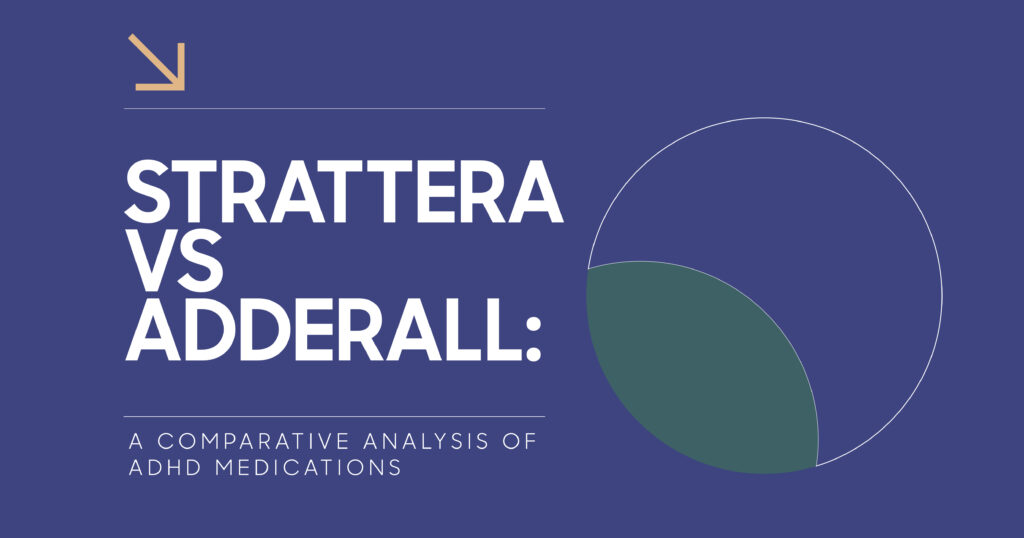When it comes to managing ADHD, no two treatment paths are exactly the same, and that’s especially true when comparing Strattera vs Adderall. While both medications are FDA-approved for ADHD, they work in dramatically different ways. One is a non-stimulant designed for gradual, steady relief. The other is a stimulant known for fast-acting effects.
As ADHD affects focus, impulse control, and emotional regulation, understanding the nuances between these two medications is key. This guide will walk you through side effects, dosages, effectiveness, and how each option fits into different treatment goals, whether you’re seeking a long-term strategy or immediate symptom relief.
Overview of Strattera and Adderall as ADHD Treatments
When treating ADHD, both Strattera and Adderall are widely prescribed, but they represent two very different approaches. While Adderall is a stimulant medication that boosts dopamine and norepinephrine levels quickly, Strattera (generic name: atomoxetine) is a non-stimulant that builds effectiveness gradually over time.
Strattera is often favored for patients who don’t respond well to stimulants, are at risk for substance misuse, or experience high anxiety. Adderall, on the other hand, tends to work quickly and is often the first-line treatment due to its immediate effects on attention and impulse control.

These two medications are both FDA-approved for ADHD but differ significantly in how they’re metabolized, how long they last, and how they affect mood and focus.
For a clinical breakdown of how these medications are used, the Cleveland Clinic’s ADHD medication guide offers helpful insight into both stimulant and non-stimulant therapies.
Understanding the Mechanisms: Stimulant Vs Non-Stimulant Medications
The most significant difference between Strattera and Adderall is how they interact with the brain. These two medications treat ADHD symptoms through different neurological pathways, and understanding their mechanisms can help patients and providers choose the right fit.
Stimulants like Adderall directly increase the availability of dopamine and norepinephrine in the brain, neurotransmitters responsible for attention, alertness, and impulse control. Non-stimulants like Strattera primarily target norepinephrine alone, working more gradually but with fewer risks related to dependency or emotional crashes.
Here’s a quick breakdown of how they work:
Adderall (Stimulant)
- Increases both dopamine and norepinephrine levels
- Fast-acting (typically within 30–60 minutes)
- Can cause a noticeable “peak” and “crash”
- Often more effective for severe or urgent symptoms
- May carry a higher risk for dependency or misuse
Strattera (Non-Stimulant)
- Selectively increases norepinephrine
- Takes 2–6 weeks for the full effect
- Provides more stable symptom control throughout the day
- Not classified as a controlled substance
- Often better for patients with anxiety or substance abuse concerns
Comparing Dosage and Prescription Practices
Strattera and Adderall aren’t just different in how they work – they’re also prescribed and dosed differently. These variations affect how quickly each drug works, how often it’s taken, and how patients experience symptom relief throughout the day.
Strattera is generally started at a low dose and gradually increased to minimize side effects. It’s usually taken once daily, offering steady coverage. Adderall, however, comes in both immediate-release (IR) and extended-release (XR) forms and often needs to be tailored more frequently based on how quickly it wears off or peaks.
Strattera Dosage: What to Expect
Strattera (atomoxetine) is a non-stimulant ADHD medication that’s typically dosed based on weight. It doesn’t provide immediate relief but builds up over time, often taking 2–6 weeks for full effectiveness. It’s usually taken once daily, and consistent dosing is key to its success.
| Patient Type | Starting Dose | Target Dose | Max Dose | Notes |
| Children (under 70 kg) | 0.5 mg/kg/day | 1.2 mg/kg/day | 1.4 mg/kg/day | Dose adjusted slowly to reduce side effects |
| Adults or teens (70+ kg) | 40 mg/day | 80 mg/day | 100 mg/day | Often taken once daily in the morning |
Adderall Dosage: What to Expect
Adderall is a stimulant medication that works quickly to reduce ADHD symptoms. It comes in immediate-release (IR) and extended-release (XR) forms. The dosage is usually adjusted based on symptom severity and how long relief is needed throughout the day.
| Form | Starting Dose | Typical Range | Max Dose | Dosing Schedule |
| Adderall IR | 5 mg once or twice daily | 10–30 mg/day | 40 mg/day | 2–3 times daily, spaced 4–6 hrs apart |
| Adderall XR | 10 mg once daily | 10–30 mg/day | 30–40 mg/day | Once daily in the morning |
Common Side Effects of Each Medication
Both Strattera and Adderall can be highly effective in managing ADHD symptoms, but like any medication, they come with potential side effects. Understanding these can help individuals and families make more informed choices with their healthcare provider.
Below is a breakdown of common side effects associated with each:
Strattera (Atomoxetine) Side Effects
- Nausea or upset stomach
- Fatigue or drowsiness
- Decreased appetite
- Dizziness
- Dry mouth
- Mood swings or irritability
- Sexual side effects (in adults)
- Increased heart rate or blood pressure (less commonly)
Adderall (Amphetamine/Dextroamphetamine) Side Effects
- Insomnia or sleep disturbances
- Loss of appetite
- Increased heart rate or blood pressure
- Anxiety or restlessness
- Dry mouth
- Headaches
- Irritability or mood changes
- Risk of dependency or misuse (especially at high doses)

Effectiveness of Strattera vs Adderall in Symptom Management
When it comes to managing ADHD symptoms, both Strattera and Adderall have proven benefits, but their effectiveness can vary depending on the individual. While Adderall typically offers quicker, more noticeable symptom relief, Strattera provides a steadier and longer-term effect, especially helpful for individuals who don’t respond well to stimulants.
Here’s a side-by-side look at how both medications perform in key areas of ADHD treatment:
| Symptom Category | Strattera | Adderall |
| Onset of Action | Gradual (2–6 weeks) | Rapid (30–60 minutes) |
| Attention/Focus | Moderately effective | Highly effective |
| Impulsivity Control | Effective (especially over time) | Very effective |
| Hyperactivity | It may take longer to address | Often improves quickly |
| Mood Regulation | Helpful for co-occurring anxiety or mood issues | Can cause or worsen mood swings in some cases |
| Daily Consistency | Stable coverage with consistent dosing | May require multiple doses or XR formulation |
| Risk of Dependence | Low (non-stimulant) | Higher (stimulant, controlled substance) |
Find the Right ADHD Treatment Plan With Treat Mental Health
Navigating ADHD treatment can feel overwhelming, especially when choosing between medications like Strattera and Adderall. That’s where we come in. At Treat Mental Health, our team helps you find a treatment plan tailored to your unique needs – whether you’re exploring non-stimulants, managing co-occurring conditions, or adjusting dosages for better balance.
Need guidance on the best option for you or your child? We’re here to help – compassionately, confidently, and clinically.
FAQs
What are the common side effects of Strattera compared to Adderall?
Strattera often causes nausea, fatigue, or appetite loss but carries little risk of dependency. Adderall, being a stimulant, may lead to insomnia, anxiety, or increased heart rate, and requires careful monitoring to avoid overuse.
How does the dosage of Strattera differ from Adderall for treating ADHD?
Strattera dosage is usually based on body weight and taken once daily, with effects building gradually. Adderall dosage varies more widely and can be taken in immediate or extended-release forms, offering fast-acting relief.
Is Strattera as effective as Adderall in managing ADHD symptoms?
Both are effective, but Adderall generally offers faster and stronger symptom control. Strattera may be better suited for patients who cannot tolerate stimulants or have coexisting anxiety disorders.
What are the differences between non-stimulant and stimulant ADHD medications like Strattera and Adderall?
Strattera (a non-stimulant) works gradually and poses less risk of addiction. Adderall (a stimulant) acts quickly and is highly effective but may cause side effects like restlessness or elevated blood pressure in some individuals.
How do Strattera and Adderall impact ADHD treatment outcomes?
When matched correctly to a patient’s needs, both can significantly improve focus, impulse control, and daily functioning. Success often depends on personal tolerance, lifestyle, and whether quick or sustained relief is needed.








